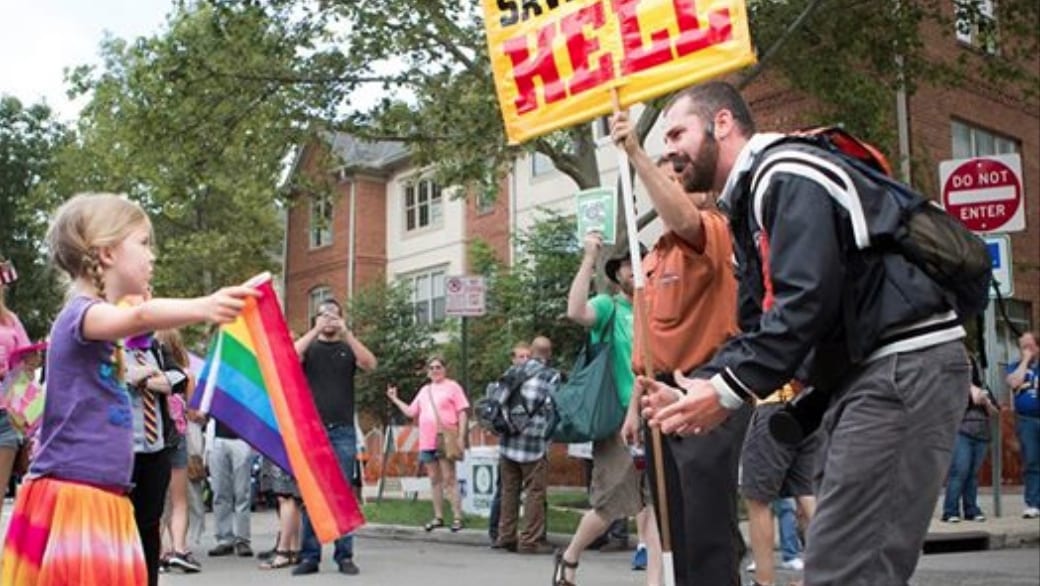In one memorable example of facing fear down with hope, a seven-year-old girl calmly resists an anti-gay street preacher in Ohio, never wavering with her Pride flag. The video, above, went viral on Youtube in June 2015.
Ryan Bowling/Youtube
I’m feeling a lot of hope as I look forward to 2016. Some amazing changes have happened over the past year and their momentum is promising.
Obviously the most exciting change of 2015 is that we have a new prime minister and he knows that Smokey Sussex is his drag name (or his porn name — I fully support both).
In all seriousness, this change in federal government has the potential to be massive.
In December, my new member of parliament, Jody Wilson-Raybould, announced the first phase of a long-awaited national inquiry into murdered and missing Indigenous women. For this announcement to come at all is important, but for it to be delivered by an Indigenous woman who is the new minister of justice shows a fundamental shift towards a government that actually represents and supports all Canadians.
This new ethos is reflected in the many scenes of Syrian refugees being welcomed to Canada with open arms. From children saying “see you in school!” to Trudeau saying “welcome home,” along with the outpouring of donations, these heartwarming displays are enough to make even an anti-colonial Cascadian like myself feel pangs of what I assume is patriotism.
So I’m feeling hopeful, and very much enjoying the feeling.
But then a headline about Trump snakes its way across my screen.
I’m not going to give him credit for everything bad in the world because I don’t think he deserves that kind of recognition. But at this point in history he could definitely be seen as the avatar of hate. A corporeal manifestation of so much of what challenges my hope.
It would be easy to dismiss Trump as a reflection of US racism, but the Islamophobia that he promotes is very much alive in Canada as well.
In stark contrast to how we have been welcoming refugees, we have also been attacking mosques and Muslim women walking on the street in niqabs.
That a woman’s right to wear a niqab was even in question — let alone a controversial and polarizing part of our last election — shows that we have more work to do around racism here too.
On both sides of the border, I see a pattern of highlighting differences between people, tangling them up in fears and scarcity, and then using this to disconnect us from one another.
Unfortunately, I see this type of disconnection happening within our queer communities as well.
Most blatant this year was a petition circulated by a group of gay and bisexual men and women to several prominent queer organizations to “Drop the T” from LGBT.
The petition tried to sever sexual orientation from gender identity and claim the trans community is hostile to the needs of the gay, lesbian and bisexual community. The petition then took these supposedly irreconcilable differences and tangled them up in a laundry list of cliched transphobic scare tactics that deserve no respect of repetition here. All leading to the notion that the LGBT community would somehow be improved by deliberately practicing the same type of exclusion within our community that we experience from the broader community.
Vancouver was plunged into controversy and disconnection of its own this year, when a gay nightclub owner hired investigators to document private queer space at a rival party, deliberately gave the documentation to media, considered using political influence to encourage stricter enforcement of bylaws on such events, and had the gall to say the motivating factor was safety. A marginalized community with limited social spaces should be supporting alternative, sex-positive events, not systematically trying to knock them down.
The worst part is that we can’t even blame Trump. These last two examples came from members of our own community promoting disconnection.
Fortunately, there is an antidote to be found in the hope.
In all those hopeful examples of positive change, we can see people embracing their differences and finding connections across them. That is what builds healthy and resilient communities.
Despite the less-than-shining examples above, embracing differences and forging connection is one of the gifts the queer community has to offer. We know what exclusion feels like. We should, and often do, promote inclusion and dignity for all.
In 2016, let’s take all that we’ve learned about loving difference in ourselves and others to help Canadians build community across difference. Let’s choose connection and hope.

 Why you can trust Xtra
Why you can trust Xtra


